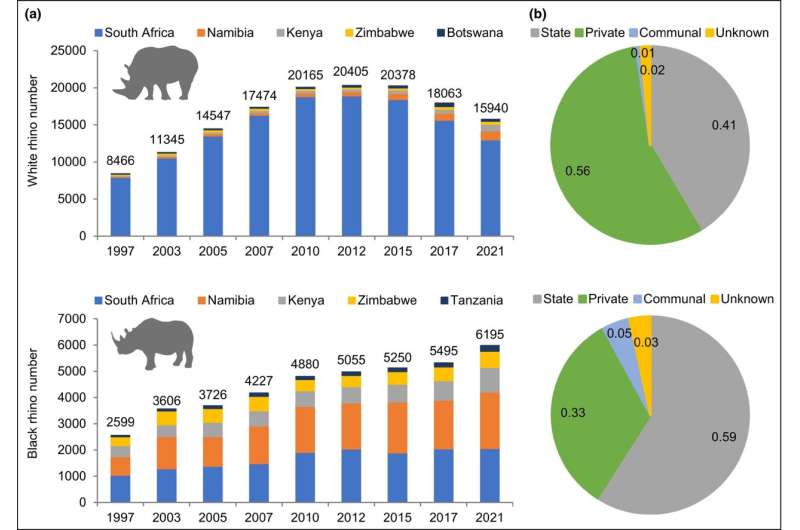This article has been reviewed according to Science X's editorial process and policies. Editors have highlighted the following attributes while ensuring the content's credibility:
fact-checked
peer-reviewed publication
trusted source
proofread
At least half of Africa's rhinos are now in private hands. New paths for rhino conservation are needed, say scientists

African rhino numbers are declining at unsustainable rates in core state-run parks which is why more than half the continent's remaining rhinos are now on private land.
Until the past decade, the largest population of rhinos was found in South Africa's Kruger National Park. This state-run park has, however, lost 76% and 68% of its white and black rhinos over the past decade, respectively. By contrast, the number of white rhinos on private land has steadily increased over the same decade, particularly in South Africa.
Private rhino owners now conserve at least half of the continents' remaining rhinos, and communal lands conserve a growing proportion as well.
In a new article published in Frontiers in Ecology and the Environment, scientists from the University of Helsinki in Finland and the Universities of Stellenbosch and Nelson Mandela in South Africa have compiled publicly available rhino population data for African countries where rhinos occur, disaggregated by state, private, and communal land types where possible. They consider the implications of an emerging shift in rhino conservation from state to private and communal lands, and chart a new path for rhino conservation.
"Private and communal landowners in several southern and East African countries can generate revenues from wildlife tourism, trophy hunting and trade in live animals, making it financially viable to use their land to conserve wildlife rather than for farming livestock," explains paper author Dr. Hayley Clements. "The result has been that hundreds of landowners conserve rhinos on their properties."
But the cost-benefit ratio of conserving rhinos is changing, explains study co-author Dr. Dave Balfour. "Accelerating poaching has meant private rhino owners now spend on average US$150,000 per year on security measures. This is far more than state parks are able to spend per rhino or per unit area conserved."
"Combined with the generally smaller size of private rhino populations (averaging 100 km2), which likely makes them easier to protect than in places like Kruger (20,000 km2), this spending on security means private rhino populations have suffered lower poaching rates than in some core state-run parks. But these rising security costs mean many landowners are not willing or able to continue conserving rhinos, with some choosing to sell their rhinos, often at a loss."
"It is important that future policy enables new incentives that compensate for rising security costs, encouraging rhino conservation on private and communal land", explains senior author Prof. Enrico Di Minin.
"For example, could landowners that conserve rhinos in extensive systems qualify for a more favorable tax structure? Could they be eligible for carbon or the emerging biodiversity credits or rhino bonds, given the role of rhinos in carbon cycling? Could they receive certifications for extensive management that increase the value of their wildlife-based tourism and hunting offerings? These are crucial questions that need to be addressed in order to support more sustainable conservation strategies for rhinos," he continues.
"If additional incentives are not enabled, we risk losing private and communal rhino custodians, and with them, half of the remaining African rhinos," concludes Dr. Clements.
Moreover, increased transparency by states about rhino numbers and their management is critical for understanding where and how best to conserve them. Availability of up-to-date data on rhino populations, poaching rates, and security costs can aid in identifying and quantifying long-term trends in rhino populations across land tenure types, inform their conservation, and help raise public awareness and support.
More information: Hayley S Clements et al, Importance of private and communal lands to sustainable conservation of Africa's rhinoceroses, Frontiers in Ecology and the Environment (2023). DOI: 10.1002/fee.2593
Journal information: Frontiers in Ecology and the Environment
Provided by University of Helsinki


















